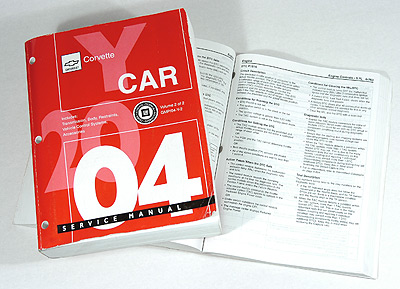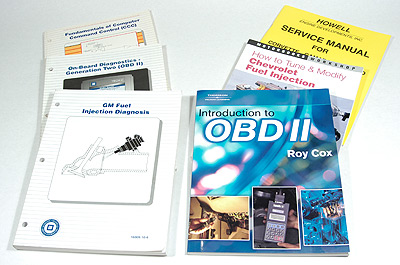Got Manuals?
© 2010 by Hib Halverson
No use without permission, All Rights Reserved

These days, Corvette FSMs are either two or three volumes and all run around 4500 pages. We have an '04 in our "fleet" and the FSM has been an invaluable resource for both writing this story and servicing the vehicle.
Image: Author
Bet you know at least one DIY who won't read service manuals. They're the folks who take forever to do a job, always know more than the "f---ing factory", believe GM service data is a poor value, but never say how much money they waste on parts they don't need. The automotive DIY community so doesn't need these guys.
Information is power-power over a Corvette's engine controls. A long time ago, it was a "Shop Manual"-about 500 pages, covering a model year's worth of Chevrolets. At the dawn of the computer era, 1980, it was 750 pages, devoted solely to Corvette. Nowadays, factory service manuals (FSM) are huge. For example: the 2004 Corvette Service Manual is two volumes of 4500 pages weighing-in at a portly, 10 lbs.
FSM's are expensive, but money well-spent. Why? 1) They help diagnose problems before you buy parts rather than getting you lost in a costly, trial-and-error, disaster. 2) The data is comprehensive. 3) Accuracy–while factory manuals sometimes contain errors, they're fairly rare. 4) They're the only place you'll find accurate wiring diagrams. A good source for Factory Service Manuals is Zip Products which currently stocks all of them up to the 2008 model year.
Older manuals use a flow-chart or "trouble-tree" format but, in 1996, GM began to convert to a tabled format with "yes" and "no" columns directing you to either the next step, a different table or the repair procedure.
Non-factory, manuals covering C4s are available from Haynes Publications which publishes both Haynes' and Chilton's consumer repair manuals. Because they're greatly condensed, they're compromised in depth. The reason most buy them is the opinion that an FSM is a poor value which, in the case of engine controls diagnostics, is a misguided belief. The Chevrolet Corvette 1984-1996 Haynes Repair Manual excludes the ZR-1 and condenses anywhere from 135-1500 pages (depending on model year) of factory data into 18 pages. We compared those pages to a FSM and found an inordinate amount of inaccurate information. A better choice is Chilton's Corvette 1984-1996 Repair Manual. It includes ZR-1 data, its chapter on engine controls is slightly larger and contains less errors.
A better, non-factory, reference for engine controls work is Service Manual for Corvette-Camaro-Firebird, published by Howell Engine Developments and distributed by MidAmerica Motorworks. It covers 1986-1993 and contains FSM excerpts on "non-scan-tool" diagnostics and an excellent discussion of basic engine controls function. We've reviewed this title and endorse it.
Chilton-branded manuals are, also, marketed to professionals. Chilton's General Motors Diagnostic Service, 2006 Edition covers virtually all 1996-2006 GM OBD II systems and contains a limited amount of diagnostic information. This book is of greatest value advanced DIYs who works on several GM vehicles, not just Vettes.

We reviewed these books during the research for this article. They're all good references but the best one is at lower left. Unfortunately, it's out-of-print, but if you can find it; buy it.
Image: Author
Suggested reading are some non-Corvette-specific books on diagnostics. Little known to DIYs are GM's own training publications, which, at one time, could be obtained by resourceful consumers. Unfortunately, with GM's cost-cutting, today, most dealer training is web-based or classroom and not accessible by laypersons. Nevertheless, some training manuals might show-up at swap meets or on eBay. Containing good information on older systems are: a 1986 GM Product Service Training publication, 1981-1986 Computer Command Control Performance Diagnosis (PN 16016.06-4), 1991 GM-STG publications, Fundamentals of Computer Command Control (PN 16016.05-2) and Fuel Injection (PN 16009.10-3) and a 1993 GM book, LT1/L99 Fuel and Emissions (PN 16009.18-3). For '96-up information, look for a very good GM-STG manual, On-BoardDiagnostics Generation Two (OBD-II), (either the original, 1994 edition (PN 16030.00-1) or a later, 1997 version (PN 16030.02-3) and an outstanding 1998 GM Training publication, GM Fuel Injection Diagnosis (PN 16009.10-6).
CarTech publishes a great book on the basics of engine controls and electronic fuel injection systems is Engine Management by Greg Banish. Another good reference is Ben Watson's How to Tune and Modify Chevrolet Fuel Injection, published by Motorbooks International. Of some use are Automotive Computer Codes and Fuel Injection Manual 1986-1999, in the Haynes Techbook series. Lastly Thompson-Delmar Learning, publisher of Chilton's professional manuals, has training publications and one of them, Introduction to OBD II by Roy Cox, a textbook aimed at college level auto shop classes, is good discussion of generic OBD II.
Lastly, a warning about one book widely marketed to Corvetters, Charles Probst's Corvette Fuel Injection and Electronic Engine Management, published by Robert Bentley Inc.: avoid this book because it contains many technical errors.
Corvette Action Center would like to thank to Brad Thatcher the Aftersales Program Readiness Manager for Global Rear Wheel Drive Performance Cars at GM for supporting the research that made this sidebar possible.
